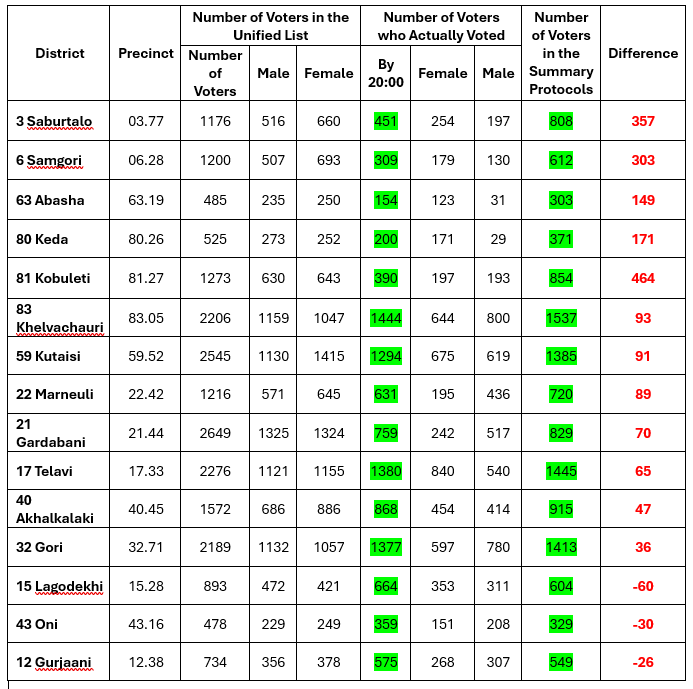The International Society for Fair Elections and Democracy issued a statement in November regarding a worrying trend that was identified by the watchdog during its analysis of data from the Central Election Commission on voter activity by gender. The concern is the difference between the number of registered male and female voters, and the proportion of voters who actually went the polling station as opposed to figures in the CEC voter database.
ISFED, based on the information it received from CEC, found that the difference in voting between male and female voters was skewed and had a practically impossible distribution. In 62 precincts, where 80-100% registered male voters voted, female turnout averaged 57%. In some precincts the male activity reaches a theoretically impossible level of more than 100 percent of registered male voters, both from unified and special voter lists. ISFED believes this indicates manipulation.
ISFED found out that:
In 275 polling booths, the difference in participation between male and female voters is greater than 20 percentage points. In 243 polling booths, the majority of males voted, while in 32 polling booths, the majority females voted.
* In 67 of the 275 precincts, the male voter participation rate is greater than the female level by more than 30%. In 12 precincts, the percentage of women who are registered to vote exceeds that of men by that same percentage point.
* The number male voters registered at 23 polling stations is greater than the number of men registered on the unified lists. In at least six polling stations the proportion of males is greater than 100% even if all voters on the special list were men.
Precincts in which these irregularities were discovered:
ISFED found unaccounted for discrepancies in the CEC’s preliminary data on the number male and female voters at the elections compared to the revised data later published. According to the preliminary results of the CEC about the number voters, 961.751 women and 1098,661 males voted on the 26th of October. However, according to revised data, female voters increased proportionally and male voters decreased – 1,053,662 (91,911 higher than initially shown) and 1,009686 (88,975 lower than initially shown).
ISFED has found that in some cases there is a large difference between the total number of voters published and the revised total. In District No. The CEC reported initially that 41 766 voters had voted but later revised the figure to 43 858. The CEC updated its site after ISFED requested detailed data for each precinct. It is now impossible to view the preliminary data about voter activity.
ISFED has also requested lists of special people (including, for example, prisoners, persons with health problems, employees from MIAs, MODs, inmates, etc.). CEC will provide additional results on the basis of these.
ISFED also notes that the CEC document it provided does not reflect the total number reflected on the CEC’s website.
The difference between 15 polling stations, for example, is:
The CEC responded on November 8 to ISFED’s analysis by stating that “counting the number of participants in the election according to gender is not a requirement established by the Electoral Code of Georgia”. The CEC also stated that “although such data may contain some inaccuracies due to the methods and practices of processing it, they are in no way and cannot be related to the results of the election and therefore cannot influence them”.
The CEC also claimed that ISFED had not taken into account people on special lists [although ISFED did say that gender-based information about special lists was unavailable at the moment, which would however not change the picture of the irregularities]. The CEC claimed that ISFED had not taken into account the people on special list [although ISFED said that gender-based information on special lists was not available at the moment which would however not change the picture]. They only admitted the errors in 11 precincts affecting 150 people. This was due to incorrect data sent by the precinct committee on the number female and male voters.
Read More @ civil.ge




